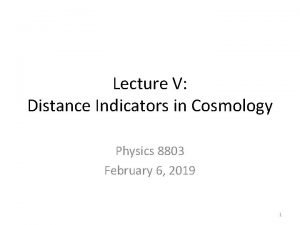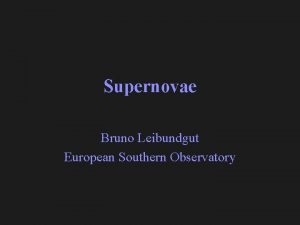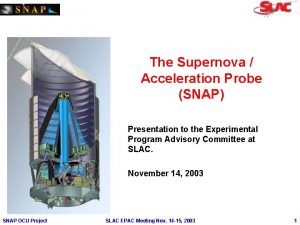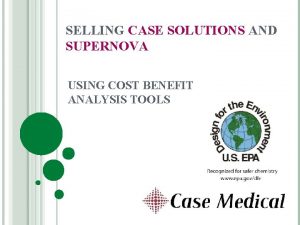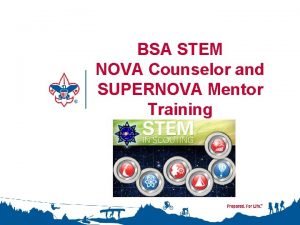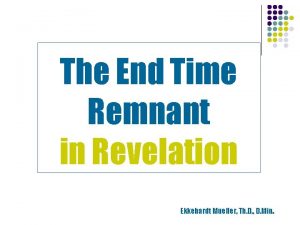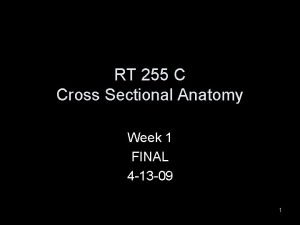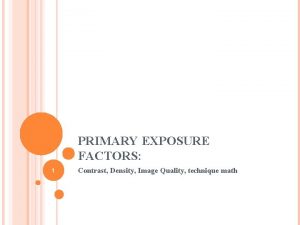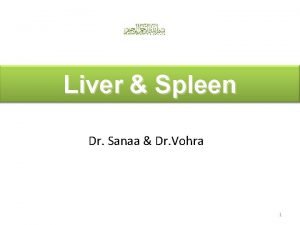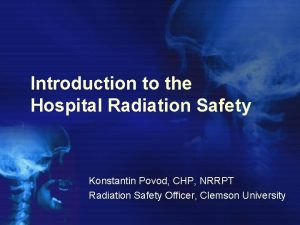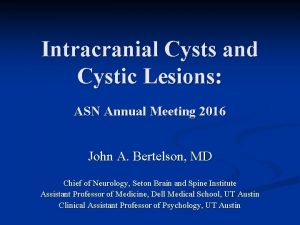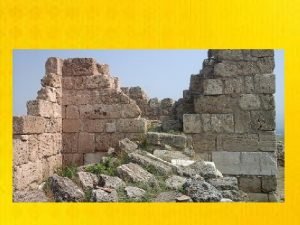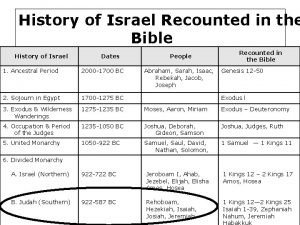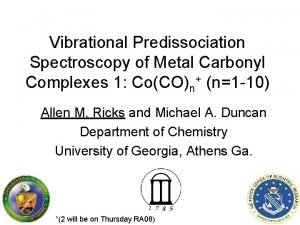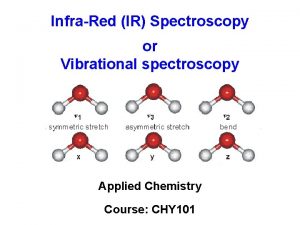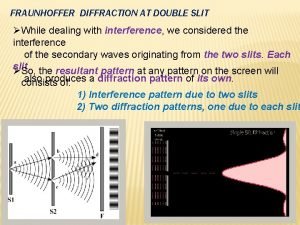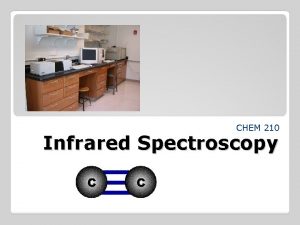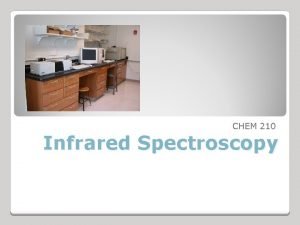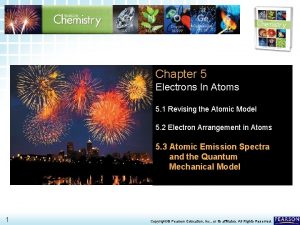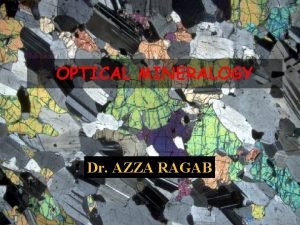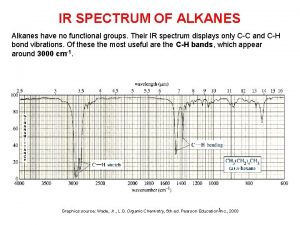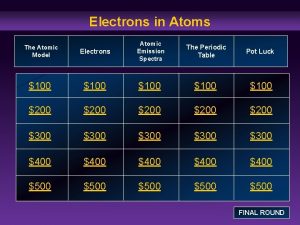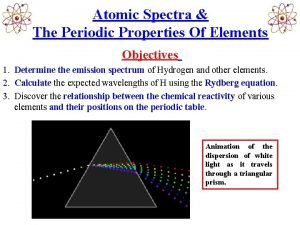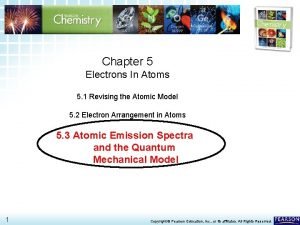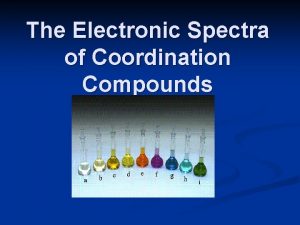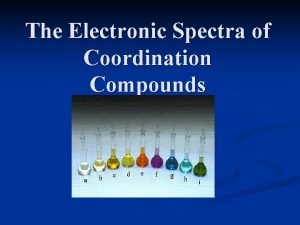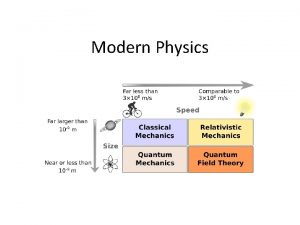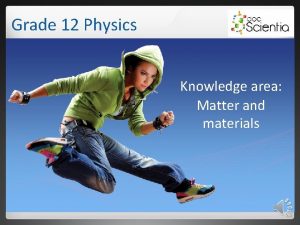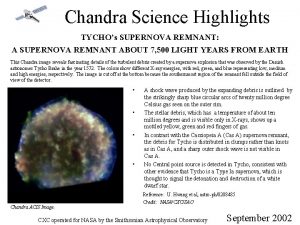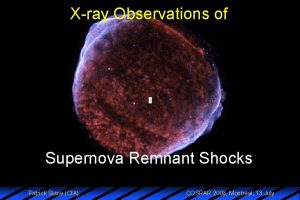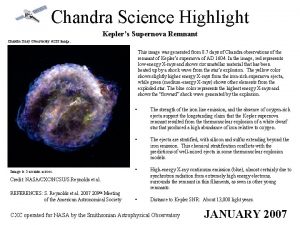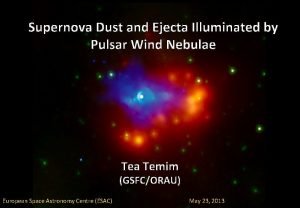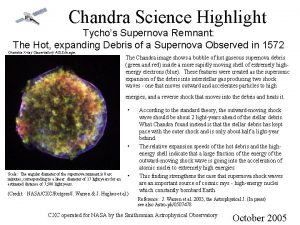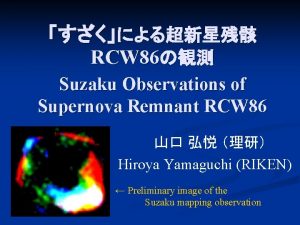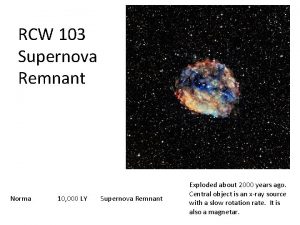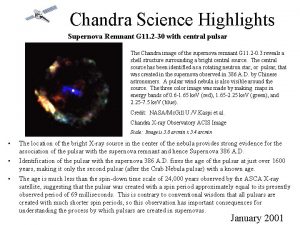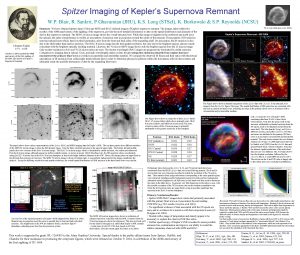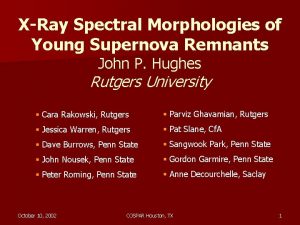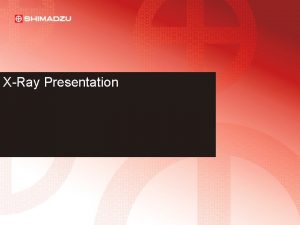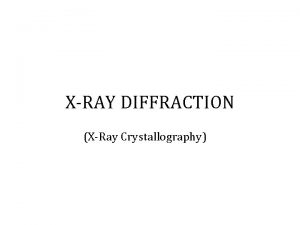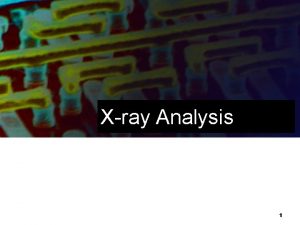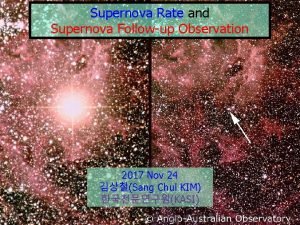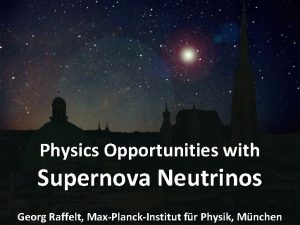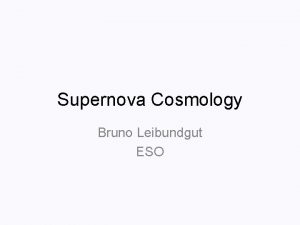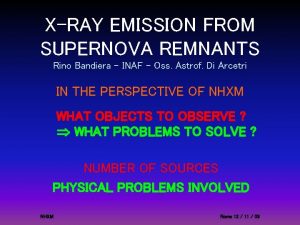Modeling Ejecta in Supernova Remnant XRay Spectra John


































- Slides: 34

Modeling Ejecta in Supernova Remnant X-Ray Spectra John P. Hughes Rutgers University § Cara Rakowski, Rutgers § Parviz Ghavamian, Rutgers § Jessica Warren, Rutgers § Pat Slane, Cf. A § Dave Burrows, Penn State § Sangwook Park, Penn State § John Nousek, Penn State § Gordon Garmire, Penn State § Peter Roming, Penn State § Anne Decourchelle, Saclay December 16, 2002 SNo. Re Cambridge, MA 1

Where’s the Ejecta? n n Optical: SNRs with high velocity oxygen-rich features Galactic: Cas A, G 292. 0+1. 8, Puppis A LMC/SMC: N 132 D, E 0540 -69. 3, E 0102. 2 -72. 2 Other: an unresolved SNR in NGC 4449 Remnants of historical SNe e. g. , SN 1006, SN 1572 (Tycho), SN 1604 (Kepler) Based on [Fe II] in absorption; X-ray spectra Ejecta-dominated SNRs e. g. , W 49 B, G 352. 7 -0. 1, G 337. 2 -0. 7, G 309. 2 -0. 6 Based on X-ray spectra (mostly ASCA) Nearly all remnants up to ages of at least ~10, 000 yrs!!! N 49, N 63 A, DEM 71, N 49 B, and E 0103 -72. 6 Based on Chandra spectro-imaging December 16, 2002 SNo. Re Cambridge, MA 2

Thermonuclear Supernovae n SN Ia (Hoyle & Fowler 1960) – No hydrogen, a solar mass of 56 Ni, some intermediate mass elements (O, Mg, Si, S, …) – Subsonic burning (deflagration) of approx. one Chandrasekhar mass of degenerate C/O – C-O white dwarf accreting H/He-rich gas from a companion – No compact remnant – Mean rate ~ 0. 3 SNU December 16, 2002 SNo. Re Cambridge, MA 3

SN Ia Integrated Yields Iwamoto et al, 1999, Ap. JS, 125, 439 December 16, 2002 SNo. Re Cambridge, MA 4

SN Ia Yields vs. Radius Mass (Msun) O 0. 056 -0. 143 Ne 0. 0008 -0. 0045 Mg 0. 027 -0. 0158 Si 0. 142 -0. 279 Fe 0. 648 -0. 834 Iwamoto et al, 1999, Ap. JS, 125, 439 December 16, 2002 SNo. Re Cambridge, MA 5

Core Collapse Supernovae n SN II, SN Ib/c (Zwicky & Baade 1934) – Massive stars that explode with (SN II) or w/out (SN Ib/c) their H envelopes – Photodisintegration of Fe, plus electron capture on nuclei, remove central P support – Core collapses, leading to NS or BH – Core stiffens, rebounds and drives an outward moving shock – Neutrinos or jets needed to produce explosion – Mean Rate ~ 1. 3 SNU December 16, 2002 SNo. Re Cambridge, MA 6

Nucleosynthesis in CC SNe n Hydrostatic nucleosynthesis – During hydrostatic evolution of star – Builds up shells rich in H, He, C, O, and Si – Amount of C, O, Ne, Mg ejected varies strongly with progenitor mass n Explosive nucleosynthesis – Some mechanism drives a shock wave with 1051+ erg through the Fe-core – Burning front T’s of ~109 K cause explosive O- and Siburning – Only affects the central parts of the star – outer layers retain their pre-SN composition December 16, 2002 SNo. Re Cambridge, MA 7

Explosive Nucleosynthesis Process T (109 K) Main Products Explosive complete Si-burning 5. 0 “Fe”, He Explosive incomplete Si-burning 4. 0 Si, S, Fe, Ar, Ca Explosive O-burning 3. 3 Explosive Ne/C-burning December 16, 2002 1. 2 SNo. Re Cambridge, MA O, Si, S, Ar, Ca O, Mg, Si, Ne 8

Typical Mass Fractions Element O Ne Mg Si S Ar Ca Fe December 16, 2002 Ex Ne 0. 72 0. 13 0. 09 0. 02 Ex O 0. 45 0. 005 0. 30 0. 20 0. 025 0. 02 SNo. Re Cambridge, MA Ex Si-i Ex Si-c 0. 40 0. 25 0. 06 0. 05 0. 20 0. 70 9

Major Yields (in Solar Masses) Element 13 Mo 15 Mo 20 Mo 25 Mo C 0. 060 0. 083 0. 115 0. 148 O 0. 218 0. 433 1. 480 3. 00 Ne 0. 028 0. 039 0. 257 0. 631 Mg 0. 012 0. 046 0. 182 0. 219 Si 0. 047 0. 071 0. 095 0. 116 S 0. 026 0. 023 0. 025 0. 040 Ar 0. 0055 0. 0040 0. 0045 0. 0072 Ca 0. 0053 0. 0037 0. 0062 Fe *0. 150* *0. 130* 0. 075 *0. 050* December 16, 2002 SNo. Re Cambridge, MA 10

SN II Yields vs. Radius 20 Msun model Hydrostatic nucl. M>2. 05 Explosive nucl. ~1. 6 <M<2. 05 Mass cut set so 0. 075 Msun of Fe is ejected Thielemann, Nomoto, and Hashimoto, 1996, Ap. J, 460, 408 December 16, 2002 SNo. Re Cambridge, MA 11

Uncertainties n Thermonuclear SNe – Physics of flame front propagation – Precise progenitor system unknown – rate of accretion and composition unknown n Core Collapse SNe – Explosion mechanism unknown – Location of mass cut (compact object/ejecta) – Convection during He-burning – 12 C(a, g)16 O reaction rate December 16, 2002 SNo. Re Cambridge, MA 12

Useful General References n n n Trimble 1982, Rev Mod Phy, 54, 1183 (Supernovae Part I) Trimble 1983, Rev Mod Phy, 55, 511 (Supernovae Part II) Bethe 1990, Rev Mod Phy, 62, 801 (Supernova Mechanisms) Arnett 1996, “Supernovae and Nucleosynthesis” (Princeton University Press: Princeton) Wallerstein et al, 1997 Rev Mod Phy, 69, 995 (update of B 2 FH) December 16, 2002 SNo. Re Cambridge, MA 13

X-ray Emission/Atomic Processes Continuum emission – thermal bremsstrahlung: Line emission: Abundance of element Z December 16, 2002 Ionization fraction of ion i SNo. Re Cambridge, MA 14

Abundance Determination Issues n Thermodynamic State – – – Nonequilibrium Ionization (net~105 cm-3 yr) T, n evolution with time/radius (e. g. , Sedov) Other effects: § § § Heating/cooling in pure element ejecta T e /T p Nonthermal particle (rates and excitation) – Absolute abundances (e. g. , Si/H, O/H, Fe/H) § Rely on assumption of H/He-dominated continuum – Relative abundances (e. g. , Mg/Si, O/Fe) § OK, if species have the same spatial distribution December 16, 2002 SNo. Re Cambridge, MA 15

Ejecta Mass Determination Issues Volume estimation n Clumping (reduces actual mass) n Distance (M~D 5/2) n Source of electrons n – – Measure EM = nen. IV Solar abundance: ne ~ n. H ~ n. Fe/107. 6 -12 ~ 25000 n. Fe Pure Fe: ne ~ 20 n. Fe Inferred Mpure Fe /Msolar ~ 35 December 16, 2002 SNo. Re Cambridge, MA 16

Overturning Our View of Cas A Hughes, Rakowski, Burrows, and Slane 2000, Ap. JL, 528, L 109. December 16, 2002 SNo. Re Cambridge, MA 17

Oxygen-Rich SNR G 292. 0+1. 8 Park et al 2001, Ap. JL, 564, L 39 December 16, 2002 SNo. Re Cambridge, MA 18

Oxygen-Rich SNR G 292. 0+1. 8 Ejecta Rich in O, Ne, and Mg, some Si [O]/[Ne] < 1 No Si-rich or Fe-rich ejecta December 16, 2002 SNo. Re Cambridge, MA 19

Oxygen-Rich SNR G 292. 0+1. 8 Normal Composition, CSM Central bright bar – an axisymmetric stellar wind (Blondin et al, 1996) Thin, circumferential filaments enclose ejecta-dominated material – red/blue supergiant winbd boundary December 16, 2002 SNo. Re Cambridge, MA 20

Oxygen-Rich SNR G 292. 0+1. 8 Point source Featureless power-law spectrum, photon index = 1. 7 Surrounded by diffuse X-ray/radio nebula Off center, implied speed of ~800 km/s December 16, 2002 SNo. Re Cambridge, MA 21

PSR J 1124 -5916 in G 292. 0+1. 8 n n n Discovered at Parkes (Camilo et al 2002) P=0. 1353140749 s, d. P/dt=7. 471 E-13 Characteristic age ~ 2900 yrs (SNR age ~ 1600 yrs) Not detected in coherent FFT of Chandra HRC observation 3. 5 sigma detection from Zn 2 test at radio parameters Only ~130 pulsed events in 50 ks December 16, 2002 SNo. Re Cambridge, MA 22

PSR J 1124 -5916 n n n Image Analysis: point source and elliptical gaussian (small nebula) Point source contains ~160 X-ray events Pulsed fraction high ~80% Unpulsed point source emission < 1. 4 E-3 cts/s LBB< 1033 erg/s Below standard cooling curve for 2000 yr old PSR December 16, 2002 SNo. Re Cambridge, MA 23

DEM L 71: Ejecta and Shock Physics Chandra/NASA Soft X-ray Rutgers Fabry-Perot/NOAO Hard H alpha X-ray Hughes, Ghavamian, Rakowski, and Slane, Ap. JL, 582, in press (10 Jan 2003) December 16, 2002 SNo. Re Cambridge, MA 24

Fe-Rich Ejecta December 16, 2002 SNo. Re Cambridge, MA 25

Properties of DEM L 71 Ejecta n n Outer rim: lowered abundances, ~0. 2 solar (LMC ISM) Core: enhanced Fe abundance, [Fe]/[O] > 5 times solar ( ejecta) Thick elliptical shell, 32” by 40” across (3. 9 pc by 4. 8 pc) Dynamical mass estimate Wang & Chevalier 2001 r’ ~ 3. 0 Mej = 1. 1 Mch (n/0. 5 cm-3) n EM mass estimate EM ~ ne n. Fe V MFe < 2 Msun n Main error: source of electrons Fe-rich, low mass December 16, 2002 SN Ia SNo. Re Cambridge, MA 26

DEM L 71: Shock Physics Nonradiative Balmer-dominated shock Measure post-shock proton temperature December 16, 2002 X-ray emission from thermal bremsstralung Measure post-shock electron temperature SNo. Re Cambridge, MA 27

Nonradiative Balmer Shocks n n n Nonradiative means that a radiative (cooling) zone does not form Low density (partially neutral) gas High velocity shocks Narrow component: cold H I overrun by shock, collisionally excited Broad component: hot postshock protons that charge exchange with cold HI (Chevalier & Raymond 1978; Chevalier, Kirshner, & Raymond 1980) Ghavamian, Rakowski, Hughes, and Williams 2002, Ap. J, submitted. December 16, 2002 Width of broad component yields post shock proton temperature SNo. Re Cambridge, MA 28

Constraining the Electron Temperature Fit NEI shock models to 3 spatial zones to follow evolution of Te n Study 5 azimuthal regions with sufficient Chandra statistics and broad Halpha component n Available data cannot constrain Te gradients n n Data do determine mean Te Suggest partial to compete temperature equilibration n Rakowski, Ghavamian, Hughes, & Williams 2002, Ap. J, submitted. December 16, 2002 SNo. Re Cambridge, MA 29

Results on Te/Tp from DEM L 71 Shows trend for higher equilibration for lower speed shocks n X-ray/Halpha results consistent with other purely Halpha ones n December 16, 2002 SNo. Re Cambridge, MA 30

N 63 A n Middle-aged SNR – – – n 34” (8. 2 pc) in radius 2000 -5000 yrs old 2 nd brightest LMC SNR “Crescent”-shaped features – Similar to features in Vela – Clumps of high speed ejecta – Not ejecta dominated n Triangular hole – X-ray absorption – Approx. 450 solar mass cloud – On near side n No PSR or PWN – LX < 4 x 1034 erg s-1 Warren, Hughes, & Slane, Ap. J, in press (20 Jan 2003) December 16, 2002 SNo. Re Cambridge, MA 31

N 49 B n Middle-aged SNR – 80” (19 pc) in radius – 5000 -10, 000 yrs old – Near N 49 n Bright and faint rims – LMC composition – Varying ISM density n No PSR or PWN – LX < 3 x 1034 erg s-1 n Magnesium-rich ejecta – Equivalent-width maps – No O or Ne enhancement Park, Hughes, Slane, et al. Ap. J, in prep. December 16, 2002 SNo. Re Cambridge, MA 32

SNR 0103 -72. 6 n Middle-aged SNR – – – n 87” (25 pc) in radius >10, 000 yrs old (? ? ) 2 nd brightest SMC SNR No PSR or PWN – LX < 4 x 1034 erg s-1 n Circular outer shock – Low SMC-type abundances – Why so circular? n Central excess – Apparently O, Ne, Mg rich ejecta Park, Hughes, et al. , Ap. J, in prep. December 16, 2002 SNo. Re Cambridge, MA 33

THE END December 16, 2002 SNo. Re Cambridge, MA 34
 Supernova spectra
Supernova spectra Eso supernova programm
Eso supernova programm Supernova acceleration probe
Supernova acceleration probe Supernova
Supernova Supernova
Supernova Supernova mentor
Supernova mentor Erickson nursing theory
Erickson nursing theory Dimensional modeling vs relational modeling
Dimensional modeling vs relational modeling What is a time remnant
What is a time remnant Remnant radiation
Remnant radiation Remnant radiation
Remnant radiation Porta hepatis
Porta hepatis Remnant radiation
Remnant radiation Cavum vellum interpositum
Cavum vellum interpositum Remnant radiation
Remnant radiation Remnant sermon
Remnant sermon Remnant in the bible
Remnant in the bible Fluka tutorial
Fluka tutorial Vibrational spectra of metal carbonyls
Vibrational spectra of metal carbonyls Spectra tips
Spectra tips Spectra shropshire
Spectra shropshire Amine ftir
Amine ftir Fraunhoffer diffraction
Fraunhoffer diffraction Nitro group ir
Nitro group ir Spectroscopy equations
Spectroscopy equations Atomic emission spectra and the quantum mechanical model
Atomic emission spectra and the quantum mechanical model Azza spectra
Azza spectra Ir spectra of alkanes
Ir spectra of alkanes Atomic emission spectra periodic table
Atomic emission spectra periodic table Periodic table of spectra
Periodic table of spectra Atomic emmision spectrum
Atomic emmision spectrum Microstate table for p2
Microstate table for p2 Electronic spectra of coordination compounds
Electronic spectra of coordination compounds Line spectra
Line spectra Matter and materials grade 12
Matter and materials grade 12
